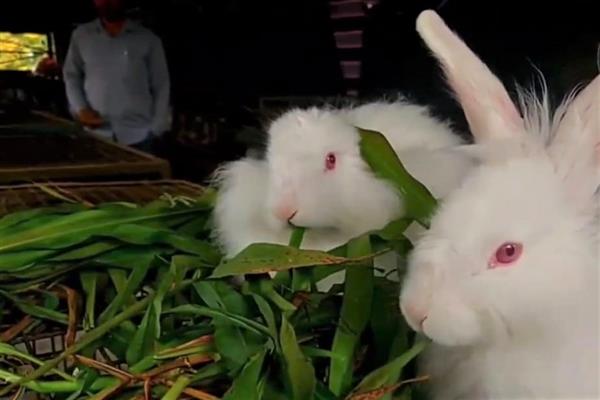Kashmir Magazine By : Kashmir Magazine | Srinagar, Publish Date: Tuesday, November 15, 2022 10:59:03 AM | Updated Date : Tuesday, November 15, 2022 10:59:03 AM

With seven different breeds available Jammu and Kashmir’s only government run Angora Rabbit Farm in Wussan village in north Kashmir’s Baramulla district has gained huge popularity in pet-loving people. The farm has become an attraction point for the locals.
“We have seven rabbit breeds available in the farm which includes Angora French, Grey Giant, Black Brown, Californian White, New Zealand White, Soviet Chinchilla and Angora German”, Dr. Irfan, Farm Manager told Kashmir News Service.
He said the farm was established in 1979, with an aim to provide alternate farming and production, at Ussan Khoei village (Palhalan) which is situated around 35-kms to the west of Srinagar.
Dr. Irfan said the farm has become a visiting point to local visitors that led to an increase in sales from the past several years. “The locals, especially youth, are visiting here frequently and asking about the breeds available. However this has led to an increase in our sales from the past several years”, he said.
“In entire Jammu and Kashmir, there is only one rabbit farm available in north Kashmir’s Baramulla. Presently there are around 1500 rabbits in the farm which are of different breeds. The farm is spread over 15 kanals of land and there are around five sheds where up to 2000 rabbits can be kept”, Dr. Irfan said. He however said, “During winters the numbers decline to just 500-600 only”.
Dr. Irfan while throwing light on its scope on Kashmir said cuniculture is another livestock activity with great scope as it is relatively easy, rewarding and takes little space compared to other livestock activities. He said rabbit farming can also provide a very valuable additional source of income in rural areas.
He said the wool getting from Angora Rabbits is of very high quality and goes costly in markets. “The wool from Angora Rabbits is of very high quality and it's blending with carpet wool of sheep and silk improves the quality of woollens to a great extent. It is a profitable business as female rabbits produce 25 to 50 kittens a year. The initial investment cost for rabbit farming is low along with quick returns, about six months after the establishment of the farm. There is good demand for the meat in the market and they also provide income from the sale of kits and manure, he added.
An official of the Animal Husbandry Department said the rabbit rearing industry can emerge as a multi-crore industry for its wool and meat value. There is a need to tap the potential of the rabbit market fully so that employment avenues are created for unemployed youth.
A senior doctor from the Animal Husbandry department said Angora rabbits are mainly raised for their wool, which is known for its quality. Angora rabbits are of many types. The differences are mainly in the amount of wool produced and the percentage of guard hair in the wool.
He said rabbits differ from hares in size, life history, and preferred habitat. In general, rabbits are smaller and have shorter ears than hares. They are born without fur and with closed eyes after a gestation period of 30 to 31 days.
“Among the various types, German Angora is the best and annually yields 1000 to 1200 gm of wool under ideal management practices. Rabbits can be adapted to any set of circumstances right from a kitchen garden to a large intensive commercial enterprise. The wool produced by rabbits is preferred for manufacturing of high value woollens which have got very good export potential,” the doctor said.
Dr. Irfan, Farm Manager said people prefer rabbits as pets instead of using them for meat consumption. Mostly local villages in the surroundings of farm purchase rabbits for meat consumption while people prefer to buy the Russian Chinchilla and German Angora for keeping them as pets.
He said the farm has gained popularity over the recent years and people from different parts of the valley visit our farm to purchase rabbits for both pet keeping and meat purposes. “During pandemic times, the farm witnessed good response from people that led to increase in sales as well”, he added.
Another caretaker of the Angora Rabbit Farm told KNS that after 2010 the farm witnessed satisfactory increase in sales and with the passing of each day, the farm has gained popularity across Kashmir valley.
“In year 2011-2012, rabbits' worth rupees one lakh were sold and similarly in 2013-2014, sales grew marginally to 1.33 lakh and in 2015 sales touched the record at 2.65 lakh. Presently there are about two-dozen employees working in the farm while dozens of families are indirectly associated with the business”, he said.
He said the rabbit farm has a huge potential to deal with the existing unemployment in J&K. He urged upon educated youth to come forward and establish their units and become job givers instead of job seekers.
“The unemployed youth of J&K is currently in a trauma due to little avenues in the government sector. They should move on and come forward to establish their own units. This way they will become job givers instead of job seekers”, he added.